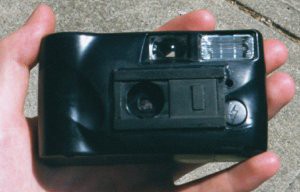
Note: This page is not only incomplete, but also now sadly out of date. Only PinCam 1.1 is covered, not the wonderful new PinCam 2.0. Please hassle me until I flesh this out with more complete information.
Many people make pinhole cameras out of very simple materials such as oatmeal boxes and film canisters. I appreciate the minimalism of that, but I for one would quite inconvenient to use such devices. For the most part, what I want is a pinhole camera with the convenience of an ordinary 35mm camera: load a roll of film, take a bunch of pictures, and drop the roll off for standard developing. Sure, there are design specs available to make your own box camera with film spools, but they're generally for large format film; and they don't control the film advancement precisely, you have to guess when you've advanced by one frame. That's two strikes against standard processing.
Since what I want is basically a no-frills 35mm camera with a pinhole in place of a lens, I simply modified an ordinary 35mm camera. I went to the nearest store and bought myself the cheapest disposable camera they had. I ripped it apart and removed the lens and shutter assembly, replacing them with a pinhole and a plastic shutter I can slide open and closed by hand. (Actually, the first iteration had a shutter constructed from card stock. This worked, but it wore out quickly and was highly susceptible to jams. Plastic sheeting slides much more easily and is an all-around superior choice.) The results can be seen below:
Give yourself 10 points if you can spot what's wrong with this picture.
Now, to take a picture, all I have to do is set the camera where I want it, slide open the shutter, time the exposure, and slide the shutter closed. To advance to the next frame, I click the original snapshot button to release the sprockets, then wind the film until they engage the lock again. Simple! (Well, there are some tricky bits...)
"So," you may be wondering, "how long are these exposures, anyway?" Well, it's highly variable, depending on the details of the pinhole's size (mine is .23mm) and distance from the film (21mm), the lighting conditions, and the film's speed rating (I generally prefer ASA 400). There are formulas that can be used, but they're not a whole lot of good without a light meter. I keep a notebook with me whenever I'm using my camera, and make a note of the conditions and exposure time of every pinhole photo I take. (I've made an effort to note the exposure times on this web site, as well.) With a little experience with a particular camera, it's quite possible to get good results with just a little estimation. I've found that film is generally rather forgiving, yeilding good (or at least acceptable) results over a surprizingly wide range of exposure times.